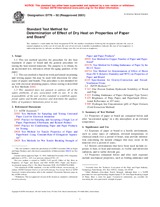We need your consent to use the individual data so that you can see information about your interests, among other things. Click "OK" to give your consent.
ASTM D776-92(2001)
Standard Test Method for Determination of Effect of Dry Heat on Properties of Paper and Board (Withdrawn 2009)
STANDARD published on 15.9.1992
The information about the standard:
Designation standards: ASTM D776-92(2001)
Note: WITHDRAWN
Publication date standards: 15.9.1992
SKU: NS-39079
The number of pages: 3
Approximate weight : 9 g (0.02 lbs)
Country: American technical standard
Category: Technical standards ASTM
Annotation of standard text ASTM D776-92(2001) :
Keywords:
accelerated aging, aging qualitied, dry heat, paperboard, ICS Number Code 85.060 (Paper and board)
Additional information
| Significance and Use | ||||||||||||||||||||
|
Exposure of paper or board to a hostile environment, such as some types of radiation, elevated temperature, or chemical attack over a period of hours, may provide information concerning the natural changes that may occur in the material over a period of years. Hostile environments that have been used include exposure to heat, to heat and moisture, to visible and ultraviolet radiation, and to sulfur dioxide gas. Properties compared before and after such exposure include mechanical properties, such as folding endurance and tearing resistance, optical properties such as brightness and opacity, and chemical properties such as pH and alkali resistance. For additional information, see Test Methods D 828, D 829, D 919, D 2176, TAPPI Methods T 509, T 212, T 423, and T 425. For determining the effect of moist heat treatment on paper see Test Method D 4714. It has been determined that the degradation of cellulose is very sensitive to moisture.5 ,6 Comparison of accelerated aging with natural aging indicates that some moisture should be present in an accelerated aging atmosphere.7 Dry accelerated aging of cellulose is much less sensitive and probably does not rank papers in order of stability as accurately as moist accelerated aging. Dry aging is much simpler to use and may be adequate for many purposes, but moist accelerated aging should be used where the greatest correlation with natural aging is needed. |
||||||||||||||||||||
| 1. Scope | ||||||||||||||||||||
|
1.1 This test method specifies the procedure for dry heat treatment of paper or board and the general procedure for testing the heat-treated materials. The purpose is to obtain, by an accelerated test, inferences about the aging qualities of the paper. 1.2 This test method is based on work performed on printing and writing papers but may be used with discretion for other types of papers and boards. This procedure is not intended for use with electrical insulating papers, whose testing is described in Test Methods D202. 1.3 This standard does not purport to address all of the safety problems, if any, associated with its use. It is the responsibility of the user of this standard to establish appropriate safety and health practices and determine the applicability of regulatory limitations prior to use. |
||||||||||||||||||||
| 2. Referenced Documents | ||||||||||||||||||||
|
We recommend:
Technical standards updating
Do you want to make sure you use only the valid technical standards?
We can offer you a solution which will provide you a monthly overview concerning the updating of standards which you use.
Would you like to know more? Look at this page.




 Cookies
Cookies
